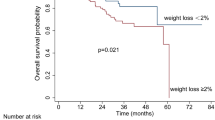Abstract
The aim of this study was to evaluate prospectively the cost of long-term feeding by percutaneous endoscopic gastrostomy (PEG). Cost analysis was carried out in 34 head and neck cancer patients, followed from the time of PEG placement to the death or the end of the study. Three main items were considered: (a) PEG placement (on an inpatient basis), subdivided into five subitems: the Freka FK-07 gastrostomy kit, materials and anaesthetic drugs used, antibiotics and antisecretory drugs, gastroscope amortization expenses and staff; (b) nutrition, considering the costs of enteral-feeding products, nutrition container and flexible tube connecting the container to the PEG; (c) patient care, dividing the patients into three groups: outpatients, home-care patients and outpatients shifting to home care during the follow-up. All patients had one medical and two nursing visits/month, and, if necessary, immediate additional access to a physician or nurse. The mean daily cost per patient of long-term feeding via PEG was obtained by adding up the mean daily costs per patient of the three items, and was compared with that of feeding via nasogastric tube, calculated in 11 patients using the same criteria. No procedure-related death nor periprocedural major or minor complications were observed. The 60-day mortality was 3/34. Seventeen patients were always seen on an outpatient basis and 8 were followed by our home-care unit; 9 outpatients shifted to home care during the follow-up. The mean duration of PEG use was 180.5 days (range 47–639). Two wound infections, treated with antibiotics, occurred during the follow-up. The mean daily costs of placement, nutrition and patient care were (Italian liras) L 2500, 24 510 and 1880 respectively (Deutschemarks: DM 2.08, 20.42 and 1.56), for a total mean daily cost of L 28,890 (DM 24.06), slightly higher than that of feeding via a nasogastric tube (L 27,340; DM 22.78). On the basis of the improved quality of life, as well as from the economic point of view, PEG can be considered the procedure of choice for enteral feeding of cancer patients, provided that a reasonably long survival can be expected.
Similar content being viewed by others
References
Apelgren KN, Zambos J (1989) Is percutaneous better than open gastrostomy? A clinical study in one surgical department. Am Surg 55:596–600
Gibson SE, Wenig BL (1992) Percutaneous endoscopic gastrostomy in the management of head and neck carcinoma. Laryngoscope 102:977–980
Gibson SE, Wenig BL, Watkins JL (1992) Complications of percutaneous endoscopic gastrostomy in head and neck cancer patients. Ann Otol Rhinol Laryngol 101:46–50
Hull MA, Rawlings J, Murray FE, Field J, McIntyre AS, Mahida YR, Hawkey CJ, Allison SP (1993) Audit of outcome of long-term enteral nutrition by percutaneous endoscopic gastrostomy. Lancet 341:869–872
Jones M, Santanello SA, Falcone RE (1990) Percutaneous endoscopic vs surgical gastrostomy. J Parenter Enteral Nutr 14:533–534
Kinney JA (1980) Caloric and nitrogen requirements in catabolic states. In: Karran SJ, Alberti KGM (eds) Practical nutritional support. Pitman, London, pp 81–93
Kirby DF, Craig RM, Tsang TK, Plotnick BH (1986) Percutaneous endoscopic gastrostomies. A prospective evaluation and review of the literature. J Parent Enteral Nutr 10:155–159
Larson DE, Burton DD, Schroeder KW, Di Magno EP (1987) Percutaneous endoscopic gastrostomy: indications, success, complications and mortality in 314 consecutive patients. Gastroenterology 93:48–52
Mamel JJ (1989) Percutaneous endoscopic gastrostomy. Am J Gastroenterol 84:703–710
Nelson JK, Palumbo PJ, O'Brien PC (1986) Home enteral nutrition: observations of a newly established program. Nutr Clin Pract 1:193–199
Park RHR, Allison MC, Lang J, Spence E, Morris AJ, Danesh BJZ, Russel RI, Mills PR (1992) Randomised comparison of percutaneous endoscopic gastrostomy and nasogastric tube feeding in patients with persisting neurological dysphagia. Br Med J 304:1406–1409
Sartori S, Trevisani L, Donati D, Gilli G, Tassinari D, Nielsen I, Malacarne P (1993) Percutaneous endoscopic gastrostomy. Personal experience and preliminary results of a long-term follow-up. Riv Ital Nutr Parenter Enter 11:174–181
Stiegmann GV, Goff JS, Silas D, Pearlman N, Sun J, Norton L (1990) Endoscopic versus operative gastrostomy: final results of a prospective randomized trial. Gastrointest Endosc 36:1–5
Taylor CA, Larson DE, Ballard DJ, Bergstrom LR, Silverstein MD, Zinmeister AR, Di Magno EP (1992) Predictors of outcome after percutaneous endoscopic gastrostomy: a community-based study. Mayo Clin Proc 67:1042–1049
The Criteria Committee of the New York Heart Association (1979) Nomenclature and criteria for diagnosis of diseases of the heart and great vessels, 8th edn. New York Heart Association, New York
Vaughan JR, Scott JS, Edelman DS, Unger SW (1991) Tracheostomy. A new indication for percutaneous endoscopic gastrostomy tube placement. Am Surg 57:214–215
Wicks C, Gimson A, Vlavianos P, Lombard M, Panos M, Macmathuna P, Tudor M, Andrews K, Westaby D (1991) Assessment of the percutaneous endoscopic gastrostomy feeding tube as part of an integrated approach to enteral feeding. Gut 33:613–616
Wolfsen HC, Kozarek RA, Ball TJ, Patterson DJ, Botoman VA, Ryan JA (1990) Long-term survival in patients undergoing percutaneous endocopic gastrostomy and jejunostomy. Am J Gastroenterol 85:1120–1122
Author information
Authors and Affiliations
Rights and permissions
About this article
Cite this article
Sartori, S., Trevisani, L., Tassinari, D. et al. Cost analysis of long-term feeding by percutaneous endoscopic gastrostomy in cancer patients in an Italian health district. Support Care Cancer 4, 21–26 (1996). https://doi.org/10.1007/BF01769870
Issue Date:
DOI: https://doi.org/10.1007/BF01769870




